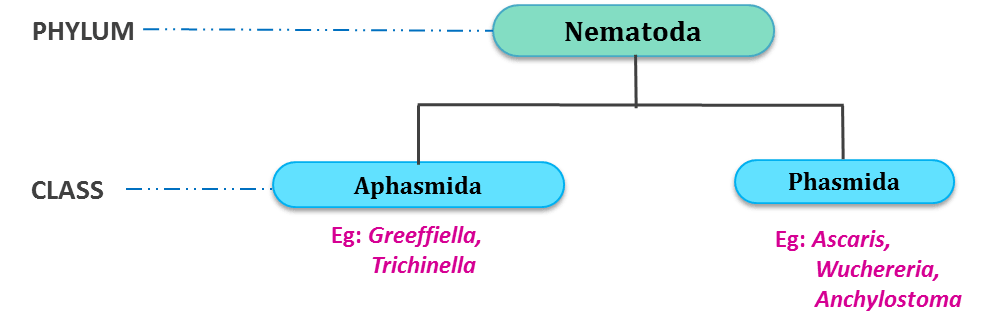Introduction
Nematodes are generally referred to as non-segmented round worms, thread worms or pinworms. They are distinct from the lower flatworms and higher annelids. They constitute the largest phylum of pseudo coelomate group. This group is also called as Aschelminthes (Askos-bladder, helminthes-worm) or Nemathelminthes (Nematos-thread, helminthes-worm).
General characters of Phylum Nematoda
- Nematodes are free-living or parasitic. Free living forms inhabit marine, fresh water or terrestrial habitats. Terrestrial species live in thin film of water surrounding soil particles. Parasites attack plants and animals.
- Most of the free living species are microscopic while many of the parasitic forms are much larger.
- In Nematodes, body is elongated and cylindrical in shape. Tissues are syncytial or cellular. Nematodes are characterised by species-specific number of cells or nuclei.
- Locomotory cilia are absent. Some have ciliated gastrodermal cells.
- Body wall of nematodes consists of cuticle, epidermis and longitudinal muscles. Circular muscles are absent.
- In nematodes true coelom is absent so, body cavity is pseudocoelom. It is not lined by mesodermal peritoneum. Pseudocoleomic fluid acts as hydrostatic skeleton. It is also useful in circulation.
- In nematodes, alimentary canal is a straight tube with an anterior terminal mouth, pharynx, intestine and rectum. In males, rectum joins reproductive system to form a cloaca. In females, rectum directly opens to the exterior by anus.
- Digestive system is complicated. Digestion is both extracellular and intracellular. Intestine is non-muscular.
- Blood vascular system and special respiratory organs are absent. Excretory system includes excretory glands or H-shaped excretory canal or both.
- Nervous system in intraepithelial in the epidermis and gut. Nerves extend anteriorly and posteriorly from circum-pharyngeal ganglionated nerve ring. Sense organs include papillae, amphids and phasmids. Amphids are anterior and are mechano-sensory and chemo-sensory. Phasmids are posterior unicellular glands that may be chemosensory or secretory or excretory in function.
- Nematodes are unisexual. Many are sexually dimorphic. Males are smaller than females and have curved posterior end, cloaca and copulatory spicules. A few are hermaphrodite. Fertilization is internal. Development includes four moults.
- Nematodes exhibit eutely. This is the phenomenon in which the cell divisions (except in gonads) cease near the end of embryonic development so that the number of cells of the adults is constant which the characteristic feature for particular species. Growth results mainly by the increase in the cell size rather than cell number.
Clasification of Phylum Nematoda
About 20,000 species have been described so far in this phylum Nematoda. Nematodes is a Greek term meaning Nema= thread and eidos= form. These are commonly referred to as threadworms or pinworms.
They are much different from the flatworms and tapeworms of the lower phyla. They form the largest phylum of pseudo coelomate groups. The classification of this phylum is much difficult as they are much diverse in their form and structure.
Aschelminthes or Nemathelminthes is considered as a distinct phylum by Hyman. He included various classes into this phyla. Other zoologists regard Aschelminthes or Nemathelminthes as a super-phylum. Various phyla included in this super-phylum are Rotifera, Gastrotricha, Kinorhynca, Nematomorph, Nematoda.
In 1933, Chitwood divided this phylum into two classes namely Phasmida and Aphasmida based on the presence and absence of caudal sensory organs.

This Phylum is divided into two classes. The following are the general characters of each of them,
Class I: Aphasmida
- It is also known as Adenophorea.
- They are free living animals.
- In these animals amphids (Anterior sense organs) occur in various shapes and phasmids (Posterior sense organs) are absent.
- There is no excretory system in these animals. If present it consists of only excretory glands and no excretory canals.
- The mesenterial tissue is well developed in these animals.
- These animals possess caudal adhesive glands.
Class II: Phasmida
- It is also known as Secernentea.
- They are mostly parasitic and some forms also exist as free-living.
- These animals have phasmids and amphids. In these animals, amphids are pore-like in structure.
- The excretory system is well developed with excretory glands and excretory canals.
- The mesenterial tissue is not well developed in these animals.
- These animals do not have caudal adhesive glands.

- Classify phylum Nematoda.
- Distinguish between Aphasmida and Phasmida in terms of excretory system.
- Distinguish between Aphasmida and Phasmida in terms of amphids and phasmids.
- What is eutely? How is it relevant to Nematoda?
- Mention few general characters of the phylum Nematode?
- Share with your friends! -


Login to post your comment here...
- or with social Account -